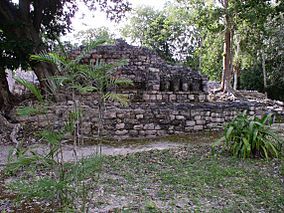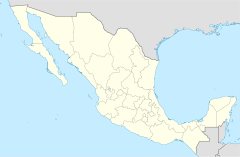Calakmul Biosphere Reserve facts for kids
Quick facts for kids Calakmul Biosphere Reserve |
|
|---|---|
| Reserva de la Biósfera de Calakmul | |
|
IUCN Category VI (Managed Resource Protected Area)
|
|

Mayan ruins of Calakmul
|
|
| Location | Calakmul Municipality, Campeche, Mexico |
| Area | 7,231 km2 (2,792 sq mi) |
| Established | 1989 |
| Governing body | National Commission of Natural Protected Areas |
The Calakmul Biosphere Reserve (which means Reserva de la Biósfera de Calakmul in Spanish) is a huge protected area in Mexico. It's located at the base of the Yucatán Peninsula, in the state of Campeche. This reserve shares a border with Guatemala to the south.
The Calakmul Biosphere Reserve was created in 1989. It covers about 7,231 square kilometers (2,792 square miles). This makes it one of the largest protected areas in Mexico. It covers more than 14% of the state of Campeche! Inside the reserve, you can find the amazing ancient Maya civilization city of Calakmul. This is one of the biggest and most important Maya sites ever discovered.
Contents
What animals and plants live in Calakmul?
The Calakmul Reserve is like a giant home for many plants and animals. It connects to another big protected area in Guatemala called the Maya Biosphere Reserve. Together, they form one of the largest and most untouched rainforests in North and Central America.
The forest here has different types of trees. You can find huge ceiba trees, Honduras mahogany, and strangler figs. There are also chaká trees and chicle trees. Overall, the reserve is home to nearly 70,000 different kinds of plants and animals. This makes it one of the most biodiverse places on Earth!
Mammals and Birds
The reserve is home to 86 different kinds of mammals. Eighteen of these are listed as endangered, rare, or threatened in Mexico. Calakmul is special because it has 5 of the 6 large wild cats found in Mexico. These include a healthy group of jaguars, as well as jaguarundis, ocelots, pumas, and margays.
Other animals you might see include Central American agoutis, Geoffroy's spider monkeys, and Guatemalan black howlers. There are also Baird's tapirs, white-nosed coatis, and many birds. Some of the birds are ocellated turkeys, crested guans, toucans, and colorful parrots.
What challenges does Calakmul face?
The Calakmul Biosphere Reserve is considered to be critically threatened. This means that quick actions are needed to keep its amazing plants and animals safe. Some of the main challenges include:
- More people living in the area.
- Hunting for food and illegal hunting (poaching).
- More tourists visiting.
- New roads and highways being built.
Growing Population
Since the 1980s, more and more people have moved into the reserve area. Also, many babies are being born there. This puts a lot of pressure on the natural resources. The local people often farm and raise animals to feed themselves. This uses up land and water.
Hunting and Poaching
Most hunting in the reserve is done by local people to feed their families. However, this hunting is having a big effect on the animal populations. Sadly, some animals are also illegally hunted (poached) by military groups in the area.
Tourism and Water
More tourists have been visiting the reserve since it was recognized by UNESCO. While tourism can be good, it has created some problems. There isn't much water in the region. The clean water near villages is often saved for tourists. This can cause a water shortage for the local people. There's a growing worry about a water crisis if the needs of both locals and tourists can't be met.
Roads and Development
Because of how the reserve was planned, two main roads cut through important parts of it. There were also ideas for a "Maya World" tourism project. This would have included a highway connecting different parts of the reserve. Even though the highway plans are on hold, new hotels are still being built in these areas.
Who protects Calakmul?
The Calakmul area was officially named a biosphere reserve in 1989 by the Mexican president, Carlos Salinas de Gortari. The main reasons were to protect the many different plants and animals, and to protect the ancient Mayan ruins.
However, there have been different ideas about how to use the land. The local people who live there have different views from government officials and environmentalists from cities.
Local Communities
The people living in the reserve are mostly farmers. They moved there in the 1960s when the Mexican government offered land. They are called campesinos (farmers) and they live off the land. They believe the environment is a place to work and grow food.
This is different from some environmentalists and government officials. These groups often believe that an "ideal environment" is one without people. They have a "do not touch" approach. Because of this, the farmers have worked together to ask for access to resources they need to farm and live.
In 1991, the Mexican president gave the farmers the job of "caring for the reserve." This meant they received money to help protect the forests. It also encouraged them to be self-sufficient in their farming. This idea is that having many different kinds of life (biodiversity) is good because it can be used in many ways.
Sometimes, these different ideas have led to disagreements. Many farmers feel that the government and city environmentalists want to use the land for their own profit. The farmers practice farming to feed themselves and don't earn a salary. They worry that new rules might make it harder for them to live off the land.
Images for kids
See also




